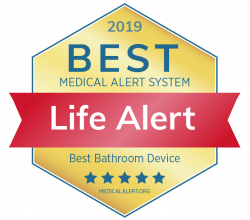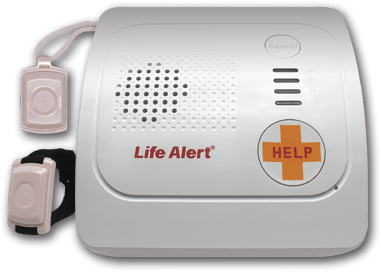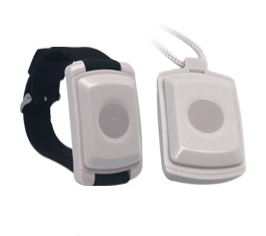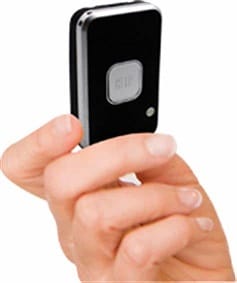Best for Protection in the Bathroom

Life Alert was founded in 1987 with the goal of helping seniors live independently at home without worrying about safety. It is one of the most well-known medical alert companies in the nation thanks to its famed “I’ve fallen and I can’t get up” television commercials. According to the company’s website, the monitoring team processes over 2 million emergency calls per year. The company also states that its monitoring services save at least one person from a “potentially catastrophic” outcome every 11 minutes.
Life Alert’s offerings include a device specifically intended for in-bathroom use. The in-bathroom device is a waterproof wall-mounted button, so users may place it in areas where bathroom falls are most common, such as the shower.
Who Life Alert Is Best For
Seniors Looking for Comprehensive Protection
Life Alert’s mobile device, On the Go, comes as a package with both In the Home and In the Bathroom devices. This simplifies things for seniors who may otherwise have to sign up for several different service plans. With Life Alert, all three devices come under one service plan and one monthly fee. This can make it easier for seniors to budget for their medical alert system.
Seniors Prone to Falls in the Bathroom
The wall-mounted In the Bathroom device is specifically designed to give seniors extra protection in one of the most high-risk areas in the home- the bathroom. Unlike other medical alert buttons on the market that are merely water-resistant, In the Bathroom is 100% waterproof. This allows it to be placed inside of the bathtub or shower, where falls are most common. Having an extra device specifically for in-bathroom use can provide peace of mind for seniors who have balance challenges.
Smartphone Users
Seniors who use a smartphone can take advantage of Life Alert’s mobile app. The app has a speed-dial option to contact the monitoring center, so it can be used as an alternative to one’s medical alert device if they ever forget to wear it or simply prefer to use their smartphone. In addition to functioning as an alternative medical alert device, the app can be used as a “virtual escort.” If a Life Alert user ever is alone and feels unsafe- for example, if they’re walking to their car alone at night- they can use the “virtual escort” feature to connect with a monitoring center operator who will stay on the line until the caller feels safe to hang up. The Life Alert mobile app adds another dimension to its services and contributes to the well-rounded nature of its device offerings.
Plans and Starting Costs
All Life Alert systems are paid for on a month-to-month basis; there are no quarterly or annual payment plans or discounts. The plans range in price from $49 for the basic in-home device to $89 for the comprehensive bundle of devices.
Unlike most other medical alert providers, Life Alert does require that all customers sign a three-year service agreement. If a customer wishes to end their service with Life Alert before the contract has ended, they may be responsible for paying for the rest of the term.
Starting Costs
All Life Alert customers must pay one-time fees, which vary based on the plan one chooses. The starting costs are as follows:
- $95 for the In the Home device
- $96 for In the Home and In the Bathroom together
- $89 for On the Go, In the Home, and In the Bathroom
The above fees all include shipping, activation, and equipment costs. There are no additional startup fees.
Device Prices and Features

In the Home
Device Features and Pricing
In the Home is a standard in-home device. Users have the choice of using a landline or cellular connection; there is no extra fee for cellular. The base station has a 72-hour backup battery and range of 800 feet, and the personal help button is shower-safe. Fall detection is not available with In the Home, or any Life Alert device. In the Home costs $49 a month.

In the Bathroom
Device Features and Pricing
In the Bathroom is a wall-mounted button that is completely waterproof, so it can be placed in the tub or shower. It functions as an additional personal help button; users may press the wall-mounted button rather than their wearable button to connect with the monitoring center. Users may also choose to place the wall-mounted button anywhere else in the home where they would like some extra protection (it does not necessarily have to be placed in the bathroom). In the Bathroom costs $69, which includes a wall-mounted button and an In the Home system.

On the Go
Device Features and Pricing
Life Alert’s mobile offering, On the Go, is a lightweight device equipped with 4G LTE and GPS. Monitoring center operators can use the GPS tracking information to easily locate callers during an emergency. On the Go is waterproof and showerproof, and has a battery life of up to 10 years. For a monthly fee of $89, users receive all three Life Alert devices- On the Go, In the Home, and In the Bathroom.
| In the Home | In the Bathroom | On the Go | |
| Monthly Cost | $49 | $69 | $89 |
| One-time Fees | $95 | $96 | $198 |
| Type of Device | In-home | In-home | Mobile |
| Connection | Landline/Cellular | Landline/Cellular | Cellular |
| Battery Life | 72-hour backup | 72-hour backup | Up to 10 years |
| Water Resistant | Yes | Yes | Yes |
| Shower-proof | Yes | Yes | Yes |
| Range | 800 feet | 800 feet | N/A |
| Fall Detection | Not available | Not available | Not available |
Optional Features
Life Alert does not currently offer optional add-on devices like lockboxes. Some of its service plans include wall-mounted buttons in the monthly cost.
Monitoring
Life Alert owns and operates its own U.S.-based monitoring center. The center is both UL-listed and TMA Five Diamond Certified. According to Life Alert’s website, the monitoring center has helped save over 400,000 lives from catastrophe since 2008. Operators notify the caller’s family members during an emergency so they are never left in the dark regarding their loved one’s health.

